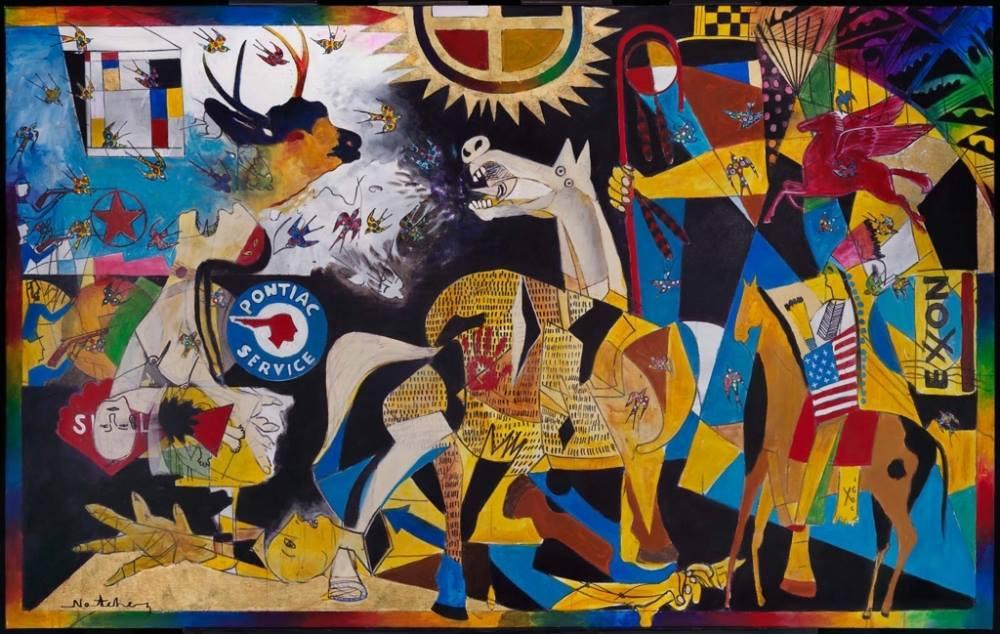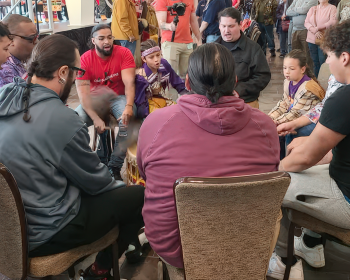
By Chantelle Bacigalupo
The room was packed on February 23, 2017 at the North American Indian Center of Boston (NAICOB) to discuss how to decolonize environmentalism with the help of an inspiring group of panelists. Stories varied from firsthand accounts from Standing Rock, to what we can do in our communities in Massachusetts, to the impact extractive industries have had on Indigenous communities throughout history. Indigenous worldviews were presented as an antithesis of mainstream concepts of environmental conservation which exclude people in the equation.
The night started with an opening prayer, “Creator, open our hearts…” and a moment of silence to honor all the Water Protectors at Standing Rock. Mahtowin Munro, the co-leader of United American Indians of New England, opened up the event. “Everyone comes here with a good spirit. The need to be here became increasingly evident, not only in Boston but also elsewhere. There is too often a gulf of understanding between largely white environmental organizations and Indigenous Peoples,” she said. “Tonight, we will be speaking about our specific Indigenous relationships with land, sky, and water, and how those are intertwined with every aspect of who we are as Indigenous human beings. Land and water are ceremony. We are caretakers of the land and water; they are part of our personal bodies and of our body politics as tribal people. In defending the land and water, we exert our inherent sovereignty as Native Nations.”
Rosalyn LaPier (Blackfeet/Metis), an assistant professor of Environmental Studies at the University of Montana, was the first panelist to speak. “I want to begin by speaking about our collective history...we do not have Native American history, we don’t have American history, we have a collective history.” Being from Montana and having family in Montana and North Dakota, she spoke of the impacts of buffalo extinction, removal of cottonwood trees, the mining of minerals, oil and gas extraction for over 100 years, and the agricultural industry on Indigenous communities. “We are now facing a time what political scholar Michael Klare calls, ‘a race for what is left.’ As this race proceeds, Montana and South Dakota will be at the center of this competition.” She joked that being an environmental studies professor means extensively presenting the problem with little explanation regarding the solution. But at this presentation she said, “That we begin to act collectively and find environmental solutions in our world. Decolonizing environmentalism is one such opportunity.”
Kristen Wyman (Nipmuc), outreach and program coordinator at Gedakina, spoke of the importance of bringing things to a local context. “I think if we can bring things to a local context, we can understand what is happening there. And while we can’t all be at Standing Rock, we can understand what we can do today, meaning here.” She discussed the history and mistreatment of Indigenous Peoples on Deer Island, MA, expressing the importance of remembering the past. “We have to come and have these talks because we can’t ever forget. As a Nipmuk person, I’m of Freshwater, I’m of this place, being born here… I live here. I have responsibility to my community and that’s the way of our people for thousands of years.” Wyman shared photos of Nipmuc people coming together recently to visit Natick via the Blackstone River that was polluted during the Industrial Revolution. “[What is happening in Standing Rock] is not anything new for our people it’s been happening for thousands of years. And simply by existing, we are resisting.”
Christian Hopkins (Narragansett/Mi’kmaq), an activist and cultural preservationist, opened up his talk by posing a number of questions. “When you think of the environment, what is the first thing that comes to mind? Through what lens are you viewing the environment? Is it through politics, is it through preservation, is it through selfish ambition, or is it spiritual?...It is important to be aware of various viewpoints, because the same topic can be approached in multiple ways.” He spoke about his experience at Standing Rock through photos sharing the various viewpoints present at the camps. “It’s very dangerous when multiple objectives are demonstrated because it pulls away from a single message,” he said. His comment illustrated parallels with the current environmental justice movement. “It is very important to be unified because our voices are very powerful,” he said in his closing statement.
Elizabeth Hoover (Mohawk and Mi’kmaq), assistant professor of American Studies at Brown University, spoke last. Her work focuses on strategies for community-based participatory research projects, and she has applied these strategies to environmental activism in Indigenous communities. Noting that communities of color face a disproportionate burden of negative environmental impacts, she stated, “Tribal communities are not like every other ethnic minority… Working with a Tribal community means sometimes having to negotiate with a Tribal government.” She mentioned the notion that for much of American history, people believed that wilderness were spaces without humans and human activity. “For the development of many of our national parks, American Indian people were cleared out in order to make the spaces look like wilderness.” For Indigenous people, “There is not necessarily a dichotomy of separation between human and the environment.”
Hoover also reminded the audience, “These issues aren’t all separate. It’s the same kind of systems that are harming each of these different communities. Some of the people that are in Standing Rock said that ‘We should go to Flint next.’ It’s our job as concerned folk. When the numbers band together, that’s when it’s going to draw attention to this issue.”
Image courtesy of 350 Mass for a Better FuturePostponed: Decolonizing Environmentalism.

